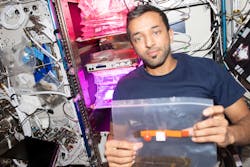Tomato? Tomahto? Let’s call the whole thing on aboard the Space Station
Horticultural lighting might be experiencing something of a slowdown on Earth, but it has had a busy month 230 miles above the planet, where astronauts on the International Space Station can’t keep their hands off the LED-nurtured tomatoes.
ISS staff have been tending to the Red Robin dwarf tomatoes which seem to have come on abundantly since the crew began preparing to grow them in early December.
The new batch marks the first time that NASA has raised tomatoes for picking and eating on the spacecraft’s Veggie system, which is the longest running of at least three different horticultural facilities the agency runs on the craft.
NASA’s daily ISS blog site can go weeks or longer without mentioning any of the botany experiments, but in a recent 3-week period it issued no fewer than six accounts of astronauts harvesting, watering, or otherwise tending to the tomatoes.
The four astronauts who arrived March 3 started tomato picking straight away, as within a week all had reached into Veggie for a helping, NASA reported on March 9. It even pictured one of the new crew members — United Arab Emirates astronaut Sultan Alneyadi — storing some of the tomatoes in a plastic bag on March 7.
In separate updates, NASA reported that U.S. astronaut Frank Rubio harvested tomatoes from Veggie on March 14 and 17, after reporting him watering the plants on Feb. 27. (In the Veggie system, water can be applied manually via a syringe, or mechanically through the PONDS — Passive Orbital Nutrient Delivery System). On March 13, U.S. astronaut Woody Hoburg checked leaves for microbial growth.
None of the updates conveyed great detail regarding the state of the fruits (tomatoes are fruits, not vegetables), nor did they specify which light recipe was in play. NASA is experimenting with two different spectra in the Veggie tomato project.
It is notable that NASA is providing such steady glimpses. It suggests that experiments in artificially lit produce might be gaining in importance on the Space Station. The astronauts have plenty of other science projects to tend to, but LED horticulture should continue to get pride of place on their to-do list, as it is the means by which people will most likely eat in future space travel and colonization.
The dwarf tomatoes mark the fifth stage of the Veggie system under the project, known as Veg-05. Earlier stages have included romaine lettuce, zinnia flowers, mizuna, pak choi, and other crops.
Veggie is the oldest of at least three LED-lit horticultural chambers on the craft. It is an open chamber from which astronauts can snip or pick produce. It germinates plants in pillows which sometimes contain a soil substrate and also contain water and fertilizer.
ISS astronauts have also picked tomatoes onboard from a separate growth chamber called XROOTS (eXposed Root On-Orbit Test System) which applies only hydroponic and aeroponic methods. NASA believes that XROOTS might scale up better than Veggie and take up less space per yield.
A third system, APH (Advanced Plant Habitat), is a completely enclosed chamber using LED lights, a clay substrate, cameras, and about 180 sensors to monitor growth. It communicates the data to Kennedy Space Center, where a team can operate APH remotely. It has a much wider spectrum of LED lights than does Veggie, including red, green, blue, white, far red, and infrared. Whereas astronauts eat the yields of Veggie, they freeze or chemically fix APH harvest — such as cabbage and thale cress — before sending it back to land for analysis.
Meanwhile on land, horticultural lighting is experiencing a slowdown as growers balk at upfront expenditures and at the energy costs of running even low-energy lighting such as LEDs. Vendors including Signify, Signify’s Fluence division, and chip maker ams Osram have all referenced a downturn on some level.
Still, plenty of work and development continues. For example, Signify has emphasized that minimizing white light can help keep energy bills down, something which could be of interest in vertical farming as well as in greenhouse growing, both of which stand to play an important role in providing global food security.
Certain investors see long-term growth in the field, such as the group that recently provided CAD $30 million to Canada’s Sollum Technologies.
–The writer of this article and headline apologizes unreservedly to George and Ira Gershwin.
MARK HALPER is a contributing editor for LEDs Magazine, and an energy, technology, and business journalist ([email protected]).
For up-to-the-minute LED and SSL updates, follow us on Twitter. You’ll find curated content and commentary, as well as information on industry events, webcasts, and surveys on our LinkedIn page and our Facebook page.

Mark Halper | Contributing Editor, LEDs Magazine, and Business/Energy/Technology Journalist
Mark Halper is a freelance business, technology, and science journalist who covers everything from media moguls to subatomic particles. Halper has written from locations around the world for TIME Magazine, Fortune, Forbes, the New York Times, the Financial Times, the Guardian, CBS, Wired, and many others. A US citizen living in Britain, he cut his journalism teeth cutting and pasting copy for an English-language daily newspaper in Mexico City. Halper has a BA in history from Cornell University.





